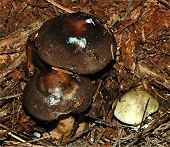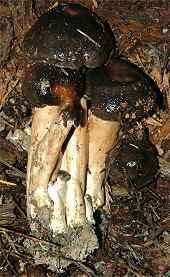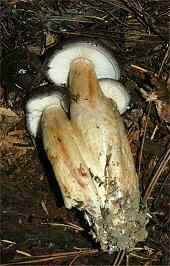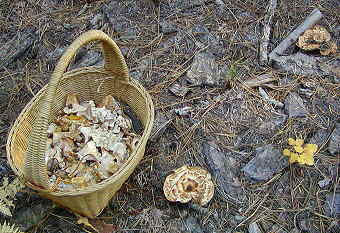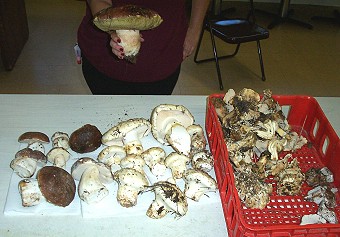|
Seventeenth Issue, November
2005
This year was a good year for fall mushrooms in our area, especially for the White Chanterelle and Shrimp Russulas. The season seemed to last much longer than ever before, as the freezing temperatures didn't really come until the middle of November. .I got to host a few forays with two fellow Mycological Society of San Francisco members, and led some forays for a few of the local residents. We discovered lots of new spots, and were pleasantly surprised by the amounts of Chanterelles we found each time we looked. I have also included lots of great pictures taken by Dimitar Bojantchev when we went out together for the one day. We also drove to Oregon for the Annual Breitenbush Mushroom Conference, our second visit, which can be seen at www.fungi-zette.com/breitenbush_2005.htm. Findings, August 11 to Novemer 30 (top)
Thursday. August 11: In spite of the continuous hot and dry weather, I actually found 3 small White Chanterelles (Cantharellus subalbidus) in one of my old chanterelle spots at about 4400 ft. Earlier that day, my daughter had found 3 small Agaricus augustus in her lawn in Greenville. All were delicious in an omelet tonight! Maybe there is still hope! Wednesday, August 17: Today we went to the Bucks lake area (I think it is at 7000 ft.), and where we had found several of them in the past in September, we only found one tiny B. regius, two small Ganoderma oregonense, but several Russulas (brevipes var. acrior, and a tan-capped species), with one large specimen being parasitized by a bright yellow hypomyces, probably a Hypomyces luteovirens.
Monday, August 22: We decided today to go up to our 4400 ft. White Chanterelle spot to see if they had grown any since my last visit. Some had. We found and collected several, varying in size from small to medium-sized. All were VERY firm-fleshed and fairly easy to clean. With these dry weather chanterelles, it doesn't seem to hurt much to rinse them under running water. We also found a small Ganoderma oregonense, my second at this elevation, and a few different species of Gastroid Agarics. I think one was the Endoptychum depressum, picture on the side, showing a small one next to a large one with part of the cap cut away, showing the almost black spore mass. Much darker than I would expect for that species, and even the smaller one had the same color spore mass inside. Endoptychum depressum was the closest match I could find. We will just have to check again in about one week. Saturday, August 27: Today, Peter
Werner (a fellow MSSFer) came up for a short foray with me, so I took
him up to my White Chanterelle spot to see what we could find. He had
stopped by on his way to camp at Lassen National Park to check the higher
elevation species. Today provided Peter with enough chanterelles for a nice meal, and we both got in a good walk. Wednesday, September 7: Today we decided to go back up to the Bucks Lake area and check again for Boletes. We actually found two small 2-3" diameter Boletus edulis buttons, one on the side of a dirt road, lots of cream-colored Russulas, several medium-sized Ganoderma oregonense, a few Ganoderma applanatum, a young Phaeolus schweinitzii, and a small but colorful Gastroboletus amyloideus, a first for me. Maybe in a few weeks more boletes will start appearing? Thursday, September 29: After being out of town for 3 weeks, I went back up to my chanterelle spot at 4400 ft to see if any White Chanterelles or Boletus edulis had come up since my last search. No boletes found yet, but I did find lots of chanterelles. I checked most of my old spots and found several at each place, this time their being large enough to show themselves. We had had a small amount of rain in the area while we were gone, and I think it made a lot of difference. These seemed to contain much more moisture than the ones I had found earlier. I didn't have to look for small bumps this time. Because they were larger and had pushed themselves above ground in most cases, the dirt clinging to them was very soft, meaning these should be much easier to clean. The total take for the day came to over 6 pounds, and I almost filled my large basket. I got tired of lugging it around, so I didn't check all my spots. Maybe tomorrow! I also found several large Russula brevipes, one Gastroboletus subalpinus, several tubers of some kind, a few tan Ramaria, plus a few Grisettes. Friday, September 30: Today I went back to 4400 ft. and checked the rest of my White Chanterelle spots. On the way, I discovered a few new spots, and this time I followed my own advice: I cleaned each one very carefully before I put it in the basket. On Thursday, I was so happy to find as many as I did, that I had just thrown them in the basket, making it very difficult to clean them later. Thus trip was almost as productive as the last, filling my basket to about half-full before I harvested my Ganoderma oregonense, that had grown to about 12 inches across. I also found some unidentified brown Gastroid Agarics with an orange-brown spore mass a separable stalk, another Gastroboletus subalpinus, more large Russulas, several white and yellow tubers of some kind, that were just breaking the surface, several of the orange Gomphus floccosus, a few more Grisettes, but still no boletes. I think in a few weeks I will recheck the area. This time it was very easy to clean the
chanterelles when I got home. However, we did see lots of the orange Scaly Chanterelles, the Gomphus floccosus, Gomphus bonarii, along with the white version (G. kaufmanii), a fresh Phaeolus schweinitzii (Dyer's Polypore), more cream-colored Russulas, one bright-red Amanita muscaria, one Pluteus cervinus (Deer Mushroom), some immature Ganoderma oregonense, one Helvella lacunosa, some of what looked like they could be Mycena pura, and several small other mushrooms I have yet to identify. We also found a few Ganoderma applanatum, but they were too heavy to pick and carry back for Lynn.
Here is a picture of the Gomphi(?), both the G. bonarii and the G. kaufmanii species. The orange one was about 3 inches across. Maybe some edulis later this month? Sunday, October 2: Yes, I went back to
my chanterelle spot again, but mainly just to take habitat pictures for a
friend in Nevada.
Monday, October 3: Since we got back from our 3-week trip to Southern CA on September 28th, I have been returning every day to my favorite White Chanterelle spots at 4400 ft., and each time, picking over 4 lbs. of chanterelles. Today was no exception. This time I wandered around then forest looking for new spots and found several, each yielding a good supply of fresh ones. I even checked near to the areas around my already over-picked spots, and found some very large but new patches - new spots to check next year. For sure, this has been my best year for them up here in Greenville. The season may last longer than I thought, judging by the freshness of some of today's find. It seemed that the very slight rain we had last night either made it easier to see the bumps, or the slight moisture resulted in a sudden burst of growth. In one of the last spots I found before I decided to call it quits for the day, I found several of the largest chanterelles I had seen for years, one having a base of over 2 inches in diameter. I would have taken a picture, but by the time I got it out of the ground, it didn't even look like a chanterelle. The largest chunk weighed around ¼ pound. I also found more large Russulas, one Gastroboletus subalpinus, more of the tan Ramaria (which seemed to be popular with the local deer), and one orange-colored coral mushroom. Now I have to finish cleaning the chanterelles! Saturday, October 15: Today, we had a visitor from the Bay Area, a fellow member of the MSSF, Dimitar Bojantchev, and I took him with me to a few of my spots to pick some boletes and white chanterelles. We found several of both, but were amazed at the other species we found along the way. Besides the white chanterelles, we found several Boletus aereus, a large but fresh Gastroboletus subalpinus, many species of Russula, including a few Shrimp Russulas (Russula xerampelina), a species of Lactarius with copious milk, some rather large Pine Spikes (Chroogomphus vinicolor), a few Gomphus bonarii, two species (I think) of Gomphidius, some Grisettes, a few different species of Suillus, many different types and colors of Tuberales, some yellow coral mushrooms, and several other species neither of us could identify (yet). I was very surprised at the number of species we saw today. Dimitar seems to have pretty good eyes for spotting mushrooms. I had left my glasses behind, as I thought we would only find chanterelles and boletes. Update: Dimitar sent me the following photographs that he had taken on that day: Click on any picture to see a larger image. Best viewed with the browser set for full screen. Tuesday, October 18: Today I went out briefly to collect a few more King Boletus near our home, I also picked a few small Shrimp Russula (Russula xerampelina) for tomorrow's dinner. We plan to make a Shrimp Russula Soufflé. One thing I have noticed since finding mixed Porcini this fall: The Boletus aereus seem to have less trouble with worms than the Boletus edulis, and the deer seem to prefer the edulis. I found more than a few worm-free aereus that had one small chunk eaten by a deer, with the whole mushroom being left above the ground and another intact, smaller one nearby. The edulis, by comparison, were usually chomped all the way to the base and everything removed except a few chunks. Something I saw today: Where I had left some smaller ones behind to check later, after removing some of the covering and replacing it, the edulis stopped growing and was riddled with worms. The aereus continued to grow (doubling in size in 3 days) and was worm-free. I'm glad we have more of the aereus. Thursday, October 20: I went back up to 4400 ft. today to see what had come up since my last visit Sunday, and brought back over 6 pounds of White Chanterelles, a group of small Oyster Mushrooms, and some small Boletus aereus. I started by checking my old spots and found a few at each, and by just searching more around the immediate area, I found more and more. Then I just wandered through the forest looking for new spots and found several large batches of Chanterelles. I also saw some new fruitings of a tan Ramaria, as well as the usual hundreds of Russulas.
I took this picture of some of the largest Gomphus bonarii I have ever seen, as well as my basket just before I decided to return back to the car. On the way back, I found a few more chanterelles, leading me to the conclusion that there are still lots more out there. Wednesday, October 27: This morning, I took a friend out to see if we could find her a few Chanterelles. I was going to take her far away from where I had been picking, but on the way and very close to the car, she spotted her first batch. Then we looked harder along the way and found several more. She was satisfied with the catch and ready to go back, but I wanted to continue further to see if I could find a King Bolete or two. We did find a few Queen Boletes, one too old King Bolete, and in addition, I picked some others for her to taste: Oyster Mushrooms, Shrimp Russulas, Pine Spikes. I also found and picked what looks like the Strawberries and Cream mushroom, the Hydnellum peckii, my first for this particular area. I sliced it up for the drier and am going to mail it to my dye mushroom friend to try, along with the others I found, which includes some additional Boletopsis subsquamosus plus a small amount of Albatrellus flettii and A. ellisii, both which I think might also give her some color. There were mushrooms popping up everywhere. We even found one huge pink-tinged Hygrophorus pudorinus. It looks like the light rain fall we had been getting recently has made a big difference. Friday, October 28: Today I took another friend (in a light rain) into the mountains to collect samples for her of the various edible mushrooms that are coming out. Besides finding lots of the same mushrooms I have been finding pretty regularly so far, we found a few very colorful ones. The first find was the striking, dark violet, almost black Cortinarius violaceus. Right near it was a couple of the small, blood-red Cortinarius sanguineus. The purple cort. was a first for me. A few feet away were two pink and white Hygrophorus pudorinus, large and very clean from the rain. Even in the gray weather, they were all beautiful! The oyster mushrooms we saw varied from dark grey to all-white. The chanterelles we collected were somewhat soggy, however. I finally keyed out a dark-capped, nice-looking, non-staining, tomentose Suillus that seems to be so prevalent right now: Suillus fuscotomentosus. Thursday, November 3: Even though we had had a small amount of snow where I had been finding lots of white chanterelles pretty regularly, with light rains both preceding and following the snow, after a few dry days, I went up to 4400 ft and looked for new spots, knowing well that the chanterelles might be pretty soggy. At the first area I found only a few, but lots of other mushrooms were popping up everywhere. Many Shrimp Russulas were seen, but I didn't pick any this time. I was just after the chanterelles. I decided to go back to one of my favorite picking spots, and when I got pretty close, I started finding new (and some large!) batches of them, all within about 500 feet of my old spot. In one area, they seemed to be all over the forest floor, and I found it very hard to avoid stepping on them. Most were pretty soggy, but those that were under pieces of bark or under duff, were pretty dry. I picked all I could hold in my basket and called it quits for the day. The basket, now full of wet chanterelles, was getting pretty heavy by then, probably weighing close to 13 pounds. On the way back home, I stopped to show (and share with) my find to a friend and took him back to show what they looked like this late in the season, which was pretty large and mostly above ground. We found a few more, but only brought back one dry one that we found under a mound. We both already had plenty moist ones to clean. When I got home, I left them out overnight, spread out on sheets of newspaper, to help remove some of the moisture. In the morning, they were still pretty soggy. I then put them in the oven on racks in cookie sheets, with only the pilot light on, and in a 3-4 hours, they looked almost back to normal. Because they had been so wet when I found them, I hadn't spend much energy cleaning them, plus I was a bit excited about finding so many. Slow drying them in the oven seemed to make them much easier to clean. If I collect more moist ones, I plan to try to completely dehydrate some in my drier to see how they hold up in a dish. Incidentally, I am still finding a few King and Queen Boletes close to home. Thursday, November 10: Today, after 2 days of clear weather, I went back to my white chanterelle spot to see if they had dried out any. Most hadn't. But because of my recent success in drying them in the oven, I started picking most all that I could find. The first few were found under large mounds of thick duff and were fairly dry, but the rest were either exposed or under thin duff, and very soggy. I only saw a few at first, but soon I started finding more and more large patches a little farther into the forest from my "spot", on the opposite side of the road. After filling my large basket to over half full, I got tired of carrying the soggy and heavy chanterelles, and I knew I had a lot more cleaning to do when I got home, so I tried to avoid picking more and left for home. I am still in the process of cleaning and lightly drying, and then cleaning them again. I think after they are fully cleaned, I will slice them all very thin and put them in my dehydrator. The ones I dried earlier seemed to have fared pretty well, chopped up in a slow-cooked wild mushroom soup mixture I made up (recipe below). The only other species of which I took much notice was a large batch of Albatrellus ovinus growing near one of the chanterelle patches. Tuesday, November 15: Cecelia and I went out this morning to take our younger granddaughter on a mushroom hunt. I mainly wanted her to see all the variety that was out. Before we got very far, I showed her a bump along the side of a dirt road, under which was a pair of White Chanterelles. While I was removing it, she uncovered another pair right next to them. We kept looking, and she noticed more mushrooms that we did. We continued finding and picking chanterelles and soon got tired. When I got home, a friend brought over what looked like Honey Mushrooms, but without the rings. I went to the home where they had been picked to see if they had rings when fresh. They didn't. Some were close to trees, and many were right next to the base of a stump. None appeared to come directly out of the wood. I first assumed that they were the ring-less Armillaria tabescens, but after sending some pictures to a few friends and rechecking the Armillaria key at http://botit.botany.wisc.edu/toms_fungi/armkey.html, I think now that they actually were the Armillaria gallica. Wednesday, November 16: A friend called this morning and wanted to show me some mushrooms he thought might be the White Chanterelles, as they were white, funnel-shaped, but had gills. I told him they sounded more like the Russula brevipes. That afternoon I went to his home, which borders on two sides with the NF, and he first showed me some mushrooms growing in his lawn next to a small tree. These turned out to be the same (or similar) species (ring-less) Honey Mushrooms like I saw yesterday. He then showed me another mushroom growing out of a stump, and this one was a large Phaeolus schweinitzii. We then started walking up the backside of his property to look for the chanterelles. On the way, we found several Shrimp Russulas and some red-latexed Lactarius rubrilacteus. I collected a few of each for him to taste later. As we approached the chanterelle spot, we found more Shrimp Russulas and Lactarius, and then we spotted the "chanterelles", or rather, Russula brevipes. Several mounds with them inside, were seen everywhere. Somewhat disappointed, we continued on and found a few of the beautiful Gomphidius subroseus which I also collected for his tasting. Along our path we spotted a few white and yellow Rhizopogons and 2 species of tomentose Suilluses, plus one all-white Suillus, which I brought back to see if I could ID. I brought back a few of the lighter-colored tomentose Suillus for his tasting, as they were the freshest. On the way back to his house, we actually found one, fairly water-logged, White Chanterelle. It also showed a few signs that it had been there for some time. We saw more patches of the Shrimp Russulas and Lactarius rubrilacteus, and another, solitary, Honey Mushroom that was pretty old. For the short time we were out there, we saw several species, many edible and many of which I did not ID, but my friend seemed pretty pleased with the findings. Wednesday, November 30: Cecelia and I braved the wet weather this morning and went down to Caribou road (2200 ft. elevation). We didn't see any boletes or chanterelles, just some Suillus, puffballs, lots of LBMs, and lots of Man on Horseback, the yellow Tricholoma flavovirens. Saw some snow patches though, and the mushrooms we brought home were pretty waterlogged. A 20-year Chanterelle study (top) While we were at the Breitenbush Mushroom Conference in October, we attended a slide show/lecture about an ongoing 20-year Chanterelle study, by Judy Roger. I had sent Judy a request to use the information we saw at the slide show, showed her what I was going to include in my report, asked her a few questions, and the bold/italic text represents her comments and answers:
A Most Memorable Hunt, by Mike Thomas, November 2005 (top) A note from me: Mike is a fairly new forager who presently lives in Magalia and has visited us here for some of his earlier hunts. His passion for the hunt is not un-typical of most of us who discovered the wonders, and tastes, of wild mushrooms.
Saving Soggy Chanterelles (top) Because the peak of the Chanterelle season is usually during a rainy spell or shortly thereafter, many of the chanterelles you bring home will be pretty soggy, and, if you left any dirt on them from the field, very difficult to clean. (From Findings, above): One evening, after I got home with many soggy chanterelles, I put them in the oven (whole) on racks in cookie sheets, with only the pilot light on, and in a 2-4 hours, they all looked almost back to normal. Because they had been so wet when I found them, I hadn't spend much energy cleaning them, plus I had been a bit excited about finding so many. Slow drying them in the oven seemed to make them much easier to clean. Woodsy Toss in the
Pan (top)
Recipe for Dried Wild Mushroom Soup Mix (top) I put this recipe together to try to make a dried mix using many of my dried mushrooms I have collected. It makes a very rich soup: Dried Mushroom Soup Mix recipe (makes approximately 2 ¼ cups)
Combine ingredients well and store in sealed container. For using mix:
Combine ingredients. Simmer slowly over low heat for ½ hour or until mushrooms are softened. Add ½ c whole cream and bring up to temperature just before serving. Featured Mushroom, the Shrimp Russula (Russula xerampelina) (top) This year, we found lots of the edible Russula xerampelina, in almost all our favorite fall spots. For the table, it is a new mushroom for me. We experimented with cooking it and were pleased with all the results. For a Russula, it has a surprisingly good taste and texture, so it lends itself to many dishes, the first of which was a Shrimp Russula Soufflé, using a recipe we found on line at http://www.rrich.com/mssouffle.html. However, we changed the recipe a bit, reducing the amount of nutmeg from 1 tbsp. to 1/8 tsp., as 1 tbsp. of nutmeg seemed way too much. For a direct link for this mushroom on the mushroomexpert.com site, complete with pictures, go to: http://www.mushroomexpert.com/russula_xerampelina.html |

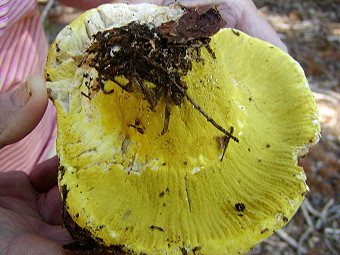
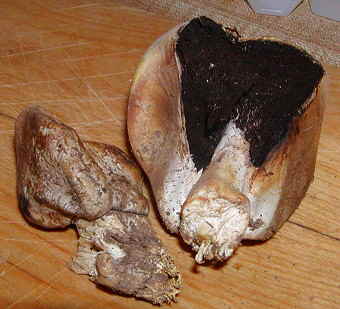
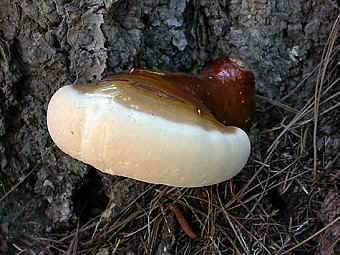
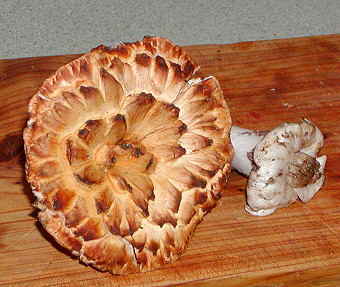
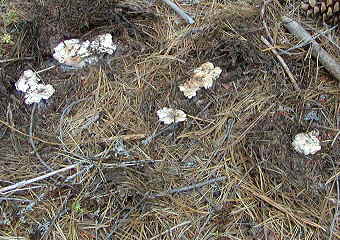
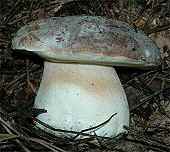
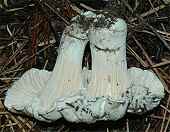
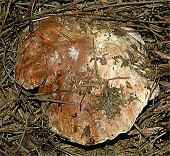
_Herman-s.jpg)
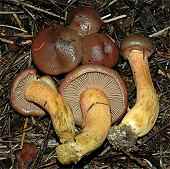
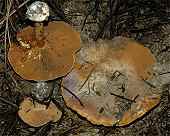
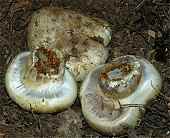
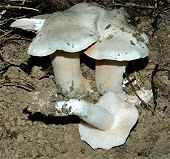
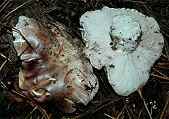
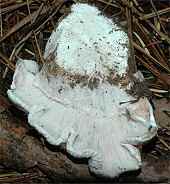
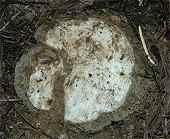
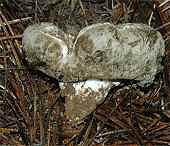
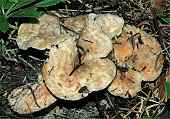
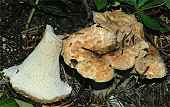
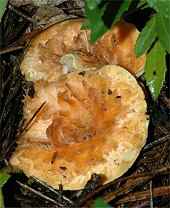
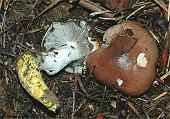
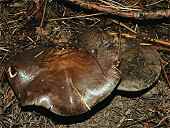
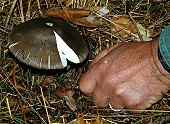
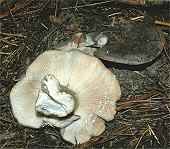
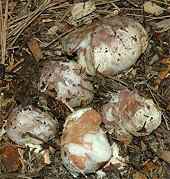
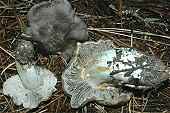
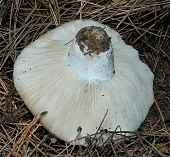
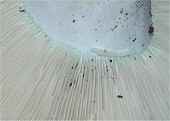
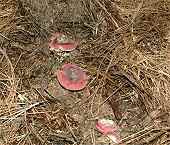
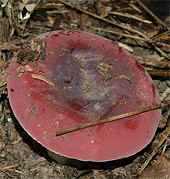
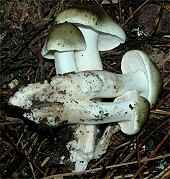
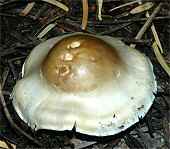
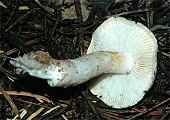
-s.jpg)
-s.jpg)
